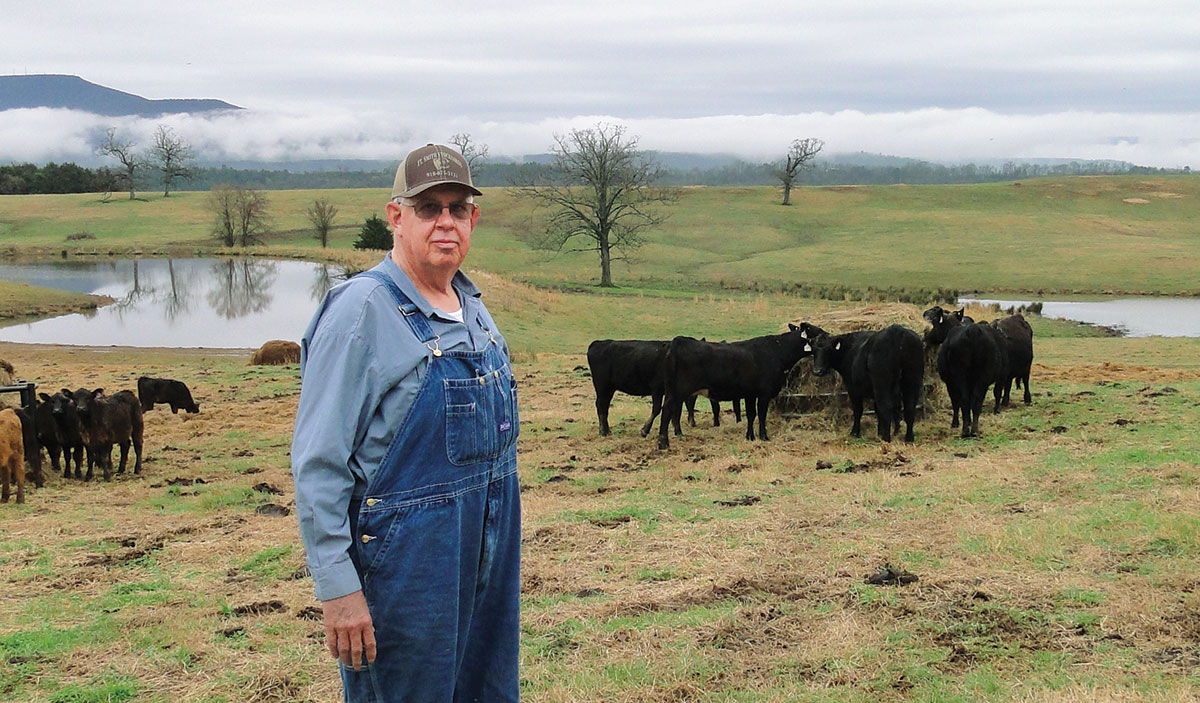
James Isaacs retired from his career in education and is now a full-time cattlemen.
The use of Stabilizer genetics gives the Isaacs’ operation a diversified revenue stream
James and Sandy Isaacs run a heavily Angus-influenced commercial herd on the land where James was raised.
James is the third generation on his farm outside of Magazine, Ark. The land is gently sloped with Mount Magazine making a compelling backdrop. James and his wife Sandy own 550 acres and rent an additional 700, some of which is unfenced and used for haying.
James and Sandy met at a church meeting. James was attending Arkansas State where he was earning a degree in animal science with a specialty in nutrition. Sandy wrote him a letter and he came to visit.
When James graduated from college, few agriculture teaching jobs were available though the local high school needed a science teacher. James returned to school and more or less stayed in school as he progressed upward through the educational system and until his children graduated from college. While working toward his science certification, James taught veterans from the Vietnam War who were interested in farming in both Magazine and Paris for 10-hours a week at night and on Saturdays. James then pursued his educational career, beginning as a science teacher then moving on to be a principal and finally the superintendent.
Now James is retired and farming full-time, something he always wanted to do. During many of those years, Sandy worked for Magnetics in the engineering department, which made ceramic magnetic cores for electronics sent to China.
The Isaacs’ farm runs 300 cows bred by 20 bulls, most of which are Stabilizers. The composite breed was developed in the 1970s in Colorado by the Leachman Cattle Company in an effort to combine the moderate size, fleshing ability and marbling of British breeds with the milk, muscle and growth of those from continental Europe.
James is able to use his bulls longer than most because his cattle are divided into seven herds with more than one bull for each herd. An additional critical factor is that he rotates the bulls methodically and culls only when they seem to be wearing out.
James began using Stabilizer bulls about 10 years ago when neighbor Bruce Stanton became a local representative for the Leachman Cattle Company. James experimented by using a few and liked the results. He maintains bull diversity by using AI performed by Dr. Charles Meisner from Boonville, Ark., on his best 40 females, developing some bull calves and heifers for future breeding. His replacement heifers are selected for AI because they have the most advanced genetics in his herd. James and Bruce have worked together by using AI on both herds and alternating who keeps the bull calves and who keeps the heifers.
Once James and Bruce raised bulls for the Leachman Cattle Company using embryo transplant. A specialist came to each of their farms to perform the process which meant they had to be ready on specific days at specific times during January. Like James, who runs only a fall-calving season for maximum profit and to avoid summer heat, the Leachman Cattle Company also wants fall bull calves. The calves were then sent back to Colorado to develop with one of them returning to this area for one of the biannual Leachman Cattle Company sales in Arkansas.
“We did that only one year because the profit did not match up well against the specific timing needed to perform the embryo transplant,” James explained. “One particular day was terribly cold, windy and difficult and not worth all the trouble.”
Calves are separated from their mothers beginning July 1. Because the weaning area holds only 75 calves at a time, herds for weaning are selected to produce that number of calves before moving to the next group.
Calves are kept at least 45 days and sold as preconditioned calves in Oklahoma City or Fort Smith, as well as at the I-40 Livestock Auction.
James never lost his interest in nutrition and believes the biggest change in the cattle industry in his area is the soil quality. He remembers as a youngster, the grasses were sparse, less nutritious and mostly unfertilized. Soil is now highly productive due to fertilizing with chicken litter for many years and spraying for weeds.
“Spraying is essential. It seems to me that chicken litter promotes weed growth with the disadvantage being that spraying tends to kill the highly nutritious clover. Grass quality, however, compensates for that loss,” James said.
Field composition is mostly Bermuda, with native grasses and a little fescue. The biggest issue is cockleburs which require some spot spraying throughout the year. James uses a modified rotational system and moves cattle every two weeks so they continually have fresh grass.
Another aspect of James’ interest in nutrition is the development of his own ration formula, a 12-percent protein combination of cracked corn, soy hull pellets and dried distillers grains. Cows are fed 2 pounds per day from December through March. James also hays 200 acres on rented and unfenced land. The hay fields typically produced 2,000 bales per year, which is mostly for personal and family use.
The Isaacs’ farm is too large for James to handle alone. Consequently, he has one full-time employee, Chance Tucknies, and weekend help from Greg Witt. Additional help comes from family: nephew Thomas Riddle, a high school science teacher in Magazine, and grandson Ethan Staton, a senior in high school.
With family members still interested in farming, the future for family ownership seems likely.







